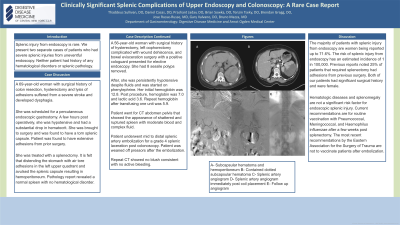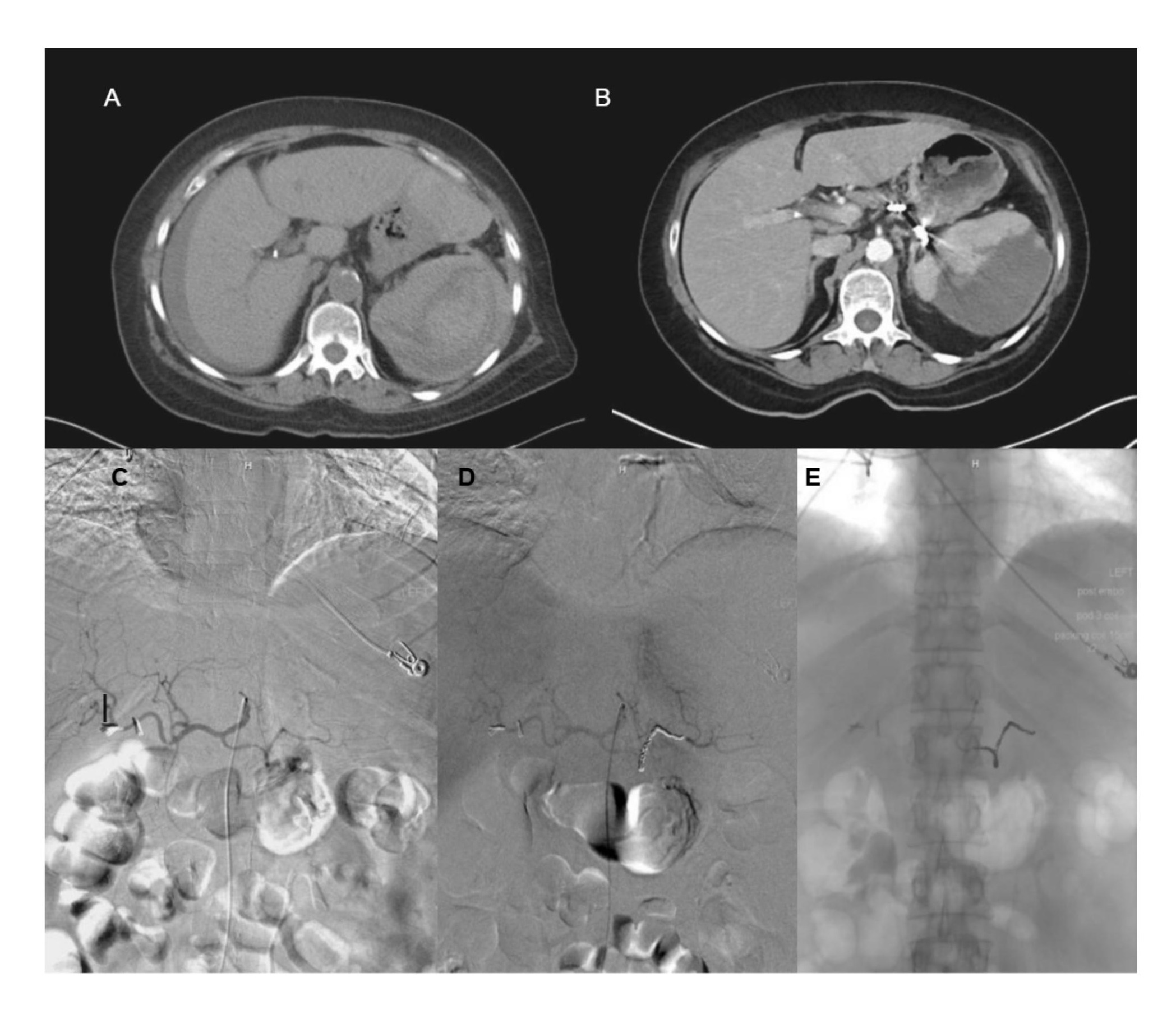Monday Poster Session
Category: General Endoscopy
P2411 - Clinically Significant Splenic Complications of Upper Endoscopy and Colonoscopy: A Rare Case Report
Monday, October 28, 2024
10:30 AM - 4:00 PM ET
Location: Exhibit Hall E

Has Audio

Thaddeus Sullivan, DO
Arnot Ogden Medical Center
Clinton, NY
Presenting Author(s)
Thaddeus Sullivan, DO1, Tenzin Tseky, DO2, Gary Valvano, DO2
1Arnot Ogden Medical Center, Clinton, NY; 2Arnot Ogden Medical Center, Elmira, NY
Introduction: Splenic injury from endoscopy is rare. We present two separate cases of patients who had severe splenic injuries from uneventful endoscopy. Neither patient had history of any hematological disorders or splenic pathology.
Case Description/Methods: A 69-year-old woman with surgical history of colon resection, hysterectomy and lysis of adhesions suffered from a severe stroke and developed dysphagia. She was scheduled for a percutaneous endoscopic gastrostomy. A few hours post operatively, she was hypotensive and had a substantial drop in hematocrit. She was brought to surgery and was found to have a torn splenic capsule. Patient was found to have extensive adhesions from prior surgery. She was treated with a splenectomy. It is felt that distending the stomach with air tore adhesions in the left upper quadrant and avulsed the splenic capsule resulting in hemoperitoneum. Pathology report revealed a normal spleen with no hematological disorder.
A 56-year-old woman with surgical history of hysterectomy, left oophorectomy complicated with wound dehiscence, and bowel evisceration surgery with a positive cologuard presented for elective endoscopy. She had 8 sessile polyps removed. After, she was persistently hypotensive despite fluids and was started on phenylephrine. Her initial hemoglobin was 12.8. Post procedure, hemoglobin was 7.0 and lactic acid 3.6. Repeat hemoglobin after transfusing one unit was 5.9. Patient went for CT abdomen pelvis that showed the appearance of shattered and ruptured spleen with moderate blood and complex fluid. Patient underwent mid to distal splenic artery embolization for a grade 4 splenic laceration post colonoscopy. Patient was weaned off pressors after the embolization. Repeat CT showed no blush consistent with no active bleeding.
Discussion: The majority of patients with splenic injury from endoscopy are women being reported up to 71.6%. The risk of splenic injury from endoscopy has an estimated incidence of 1 in 100,000. Previous reports noted 25% of patients that required splenectomy had adhesions from previous surgery. Both of our patients had significant surgical history and were female. Hematologic diseases and splenomegaly are not a significant risk factor for endoscopic splenic injury. Current recommendations are for routine vaccination with Pneumococcal, Meningococcal, and Haemophilus influenzae after a few weeks post splenectomy. The most recent recommendations by the Eastern Association for the Surgery of Trauma are not to vaccinate patients after embolization.

Disclosures:
Thaddeus Sullivan, DO1, Tenzin Tseky, DO2, Gary Valvano, DO2. P2411 - Clinically Significant Splenic Complications of Upper Endoscopy and Colonoscopy: A Rare Case Report, ACG 2024 Annual Scientific Meeting Abstracts. Philadelphia, PA: American College of Gastroenterology.
1Arnot Ogden Medical Center, Clinton, NY; 2Arnot Ogden Medical Center, Elmira, NY
Introduction: Splenic injury from endoscopy is rare. We present two separate cases of patients who had severe splenic injuries from uneventful endoscopy. Neither patient had history of any hematological disorders or splenic pathology.
Case Description/Methods: A 69-year-old woman with surgical history of colon resection, hysterectomy and lysis of adhesions suffered from a severe stroke and developed dysphagia. She was scheduled for a percutaneous endoscopic gastrostomy. A few hours post operatively, she was hypotensive and had a substantial drop in hematocrit. She was brought to surgery and was found to have a torn splenic capsule. Patient was found to have extensive adhesions from prior surgery. She was treated with a splenectomy. It is felt that distending the stomach with air tore adhesions in the left upper quadrant and avulsed the splenic capsule resulting in hemoperitoneum. Pathology report revealed a normal spleen with no hematological disorder.
A 56-year-old woman with surgical history of hysterectomy, left oophorectomy complicated with wound dehiscence, and bowel evisceration surgery with a positive cologuard presented for elective endoscopy. She had 8 sessile polyps removed. After, she was persistently hypotensive despite fluids and was started on phenylephrine. Her initial hemoglobin was 12.8. Post procedure, hemoglobin was 7.0 and lactic acid 3.6. Repeat hemoglobin after transfusing one unit was 5.9. Patient went for CT abdomen pelvis that showed the appearance of shattered and ruptured spleen with moderate blood and complex fluid. Patient underwent mid to distal splenic artery embolization for a grade 4 splenic laceration post colonoscopy. Patient was weaned off pressors after the embolization. Repeat CT showed no blush consistent with no active bleeding.
Discussion: The majority of patients with splenic injury from endoscopy are women being reported up to 71.6%. The risk of splenic injury from endoscopy has an estimated incidence of 1 in 100,000. Previous reports noted 25% of patients that required splenectomy had adhesions from previous surgery. Both of our patients had significant surgical history and were female. Hematologic diseases and splenomegaly are not a significant risk factor for endoscopic splenic injury. Current recommendations are for routine vaccination with Pneumococcal, Meningococcal, and Haemophilus influenzae after a few weeks post splenectomy. The most recent recommendations by the Eastern Association for the Surgery of Trauma are not to vaccinate patients after embolization.

Figure: A- Subcapsular hematoma and hemoperitoneum
B- Contained clotted subcapsular hematoma
C- Splenic artery angiogram
D- Splenic artery angiogram immediately post coil placement
E- Follow up angiogram
B- Contained clotted subcapsular hematoma
C- Splenic artery angiogram
D- Splenic artery angiogram immediately post coil placement
E- Follow up angiogram
Disclosures:
Thaddeus Sullivan indicated no relevant financial relationships.
Tenzin Tseky indicated no relevant financial relationships.
Gary Valvano indicated no relevant financial relationships.
Thaddeus Sullivan, DO1, Tenzin Tseky, DO2, Gary Valvano, DO2. P2411 - Clinically Significant Splenic Complications of Upper Endoscopy and Colonoscopy: A Rare Case Report, ACG 2024 Annual Scientific Meeting Abstracts. Philadelphia, PA: American College of Gastroenterology.
